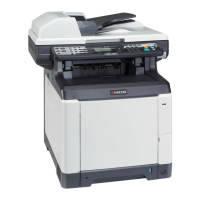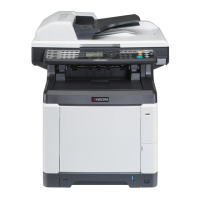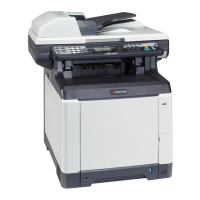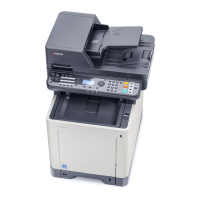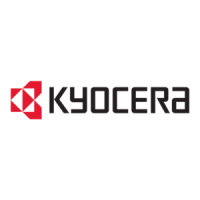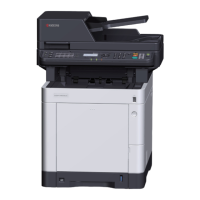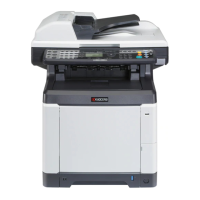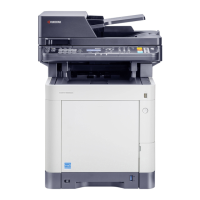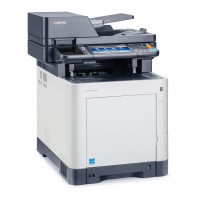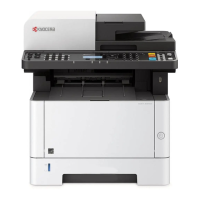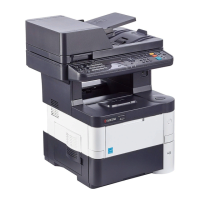Do you have a question about the Kyocera ecosys m6026cdn and is the answer not in the manual?
Records changes and updates made to the manual over time.
Provides general safety warnings and guidelines for using the machine.
Explains symbols used for safety protection and preventing property damage.
Details essential precautions to follow during machine installation.
Outlines critical safety measures for performing machine maintenance.
Covers additional safety points for general operation and environment.
Details the technical specifications of the printer and its features.
Illustrates and lists the names of major machine components.
Provides a sectional view of the machine's internal structure and components.
Details environmental conditions required for proper machine installation.
Provides step-by-step instructions for safely unpacking the machine.
Guides users through the process of installing optional expansion memory.
Explains how to access and execute maintenance items within the machine.
Details the various service modes available for machine maintenance and diagnostics.
Describes how the machine indicates paper misfeeds and how to clear them.
Explains self-diagnosis, error messages, and lists diagnostic codes.
Lists common image quality issues and their potential causes and solutions.
Addresses issues related to the machine's electrical components and power.
Covers issues related to the machine's mechanical parts and paper handling.
Lists and explains error codes related to scanning and sending functions.
Provides a classification of general error codes for communication issues.
Outlines essential safety and handling precautions before starting work.
Provides instructions for removing and reinstalling various exterior covers.
Details procedures for detaching and refitting paper feed components.
Guides on removing and reinstalling developing units for maintenance.
Explains how to detach and refit the drum units.
Outlines procedures for removing and refitting transfer/separation components.
Details the process for detaching and refitting the fuser unit.
Provides instructions for detaching and refitting various PWBs.
Covers detaching and refitting drive units for motors and related components.
Details procedures for detaching and refitting optical components like scanners.
Guides on detaching and refitting the document processor unit.
Covers detaching and refitting miscellaneous parts like fans and panels.
Step-by-step guide for upgrading the machine's firmware via USB.
Provides specific notes regarding the EEPROM transfer during engine PWB replacement.
Describes the mechanical construction of paper feeding and conveying paths.
Details the mechanical components of the drum unit and its operation.
Explains the mechanical structure of the developing unit and toner agitation.
Covers the image scanner and laser scanner units' mechanical structure.
Describes the intermediate transfer unit and secondary transfer roller mechanisms.
Details the mechanical structure of the fuser unit for toner fixing.
Explains the path and components for paper ejection and shifting.
Describes the mechanism for paper conveying during duplex printing.
Details the mechanical components of the document processor for feeding originals.
Provides an overview of the main PWBs and their locations within the machine.
Identifies the main PWBs and their functions.
Identifies and describes the function of various switches and sensors.
Lists and describes the location and function of the machine's motors.
Details other mechanical parts like clutches, lamps, and heaters.
Illustrates the electrical components within the document processor.
Lists PWB names used in service manuals and parts lists.
Explains the connectors and signals of the power source PWB.
Details the connectors and signals of the engine PWB.
Details the connectors and signals of the main PWB.
Details the connectors and signals of the drum relay PWB.
Details the connectors and signals of the DP drive PWB.
Lists recommended maintenance kits for various components.
Provides intervals for repetitive defects on various rollers and components.
Explains how to use FRPO commands for setting firmware parameters.
Details alternative commands for specific maintenance adjustments like print timing.
Records changes and updates made to the manual over time.
Provides general safety warnings and guidelines for using the machine.
Explains symbols used for safety protection and preventing property damage.
Details essential precautions to follow during machine installation.
Outlines critical safety measures for performing machine maintenance.
Covers additional safety points for general operation and environment.
Details the technical specifications of the printer and its features.
Illustrates and lists the names of major machine components.
Provides a sectional view of the machine's internal structure and components.
Details environmental conditions required for proper machine installation.
Provides step-by-step instructions for safely unpacking the machine.
Guides users through the process of installing optional expansion memory.
Explains how to access and execute maintenance items within the machine.
Details the various service modes available for machine maintenance and diagnostics.
Describes how the machine indicates paper misfeeds and how to clear them.
Explains self-diagnosis, error messages, and lists diagnostic codes.
Lists common image quality issues and their potential causes and solutions.
Addresses issues related to the machine's electrical components and power.
Covers issues related to the machine's mechanical parts and paper handling.
Lists and explains error codes related to scanning and sending functions.
Provides a classification of general error codes for communication issues.
Outlines essential safety and handling precautions before starting work.
Provides instructions for removing and reinstalling various exterior covers.
Details procedures for detaching and refitting paper feed components.
Guides on removing and reinstalling developing units for maintenance.
Explains how to detach and refit the drum units.
Outlines procedures for removing and refitting transfer/separation components.
Details the process for detaching and refitting the fuser unit.
Provides instructions for detaching and refitting various PWBs.
Covers detaching and refitting drive units for motors and related components.
Details procedures for detaching and refitting optical components like scanners.
Guides on detaching and refitting the document processor unit.
Covers detaching and refitting miscellaneous parts like fans and panels.
Step-by-step guide for upgrading the machine's firmware via USB.
Provides specific notes regarding the EEPROM transfer during engine PWB replacement.
Describes the mechanical construction of paper feeding and conveying paths.
Details the mechanical components of the drum unit and its operation.
Explains the mechanical structure of the developing unit and toner agitation.
Covers the image scanner and laser scanner units' mechanical structure.
Describes the intermediate transfer unit and secondary transfer roller mechanisms.
Details the mechanical structure of the fuser unit for toner fixing.
Explains the path and components for paper ejection and shifting.
Describes the mechanism for paper conveying during duplex printing.
Details the mechanical components of the document processor for feeding originals.
Provides an overview of the main PWBs and their locations within the machine.
Identifies the main PWBs and their functions.
Identifies and describes the function of various switches and sensors.
Lists and describes the location and function of the machine's motors.
Details other mechanical parts like clutches, lamps, and heaters.
Illustrates the electrical components within the document processor.
Lists PWB names used in service manuals and parts lists.
Explains the connectors and signals of the power source PWB.
Details the connectors and signals of the engine PWB.
Details the connectors and signals of the main PWB.
Details the connectors and signals of the drum relay PWB.
Details the connectors and signals of the DP drive PWB.
Lists recommended maintenance kits for various components.
Provides intervals for repetitive defects on various rollers and components.
Explains how to use FRPO commands for setting firmware parameters.
Details alternative commands for specific maintenance adjustments like print timing.
| Secure printing | Yes |
|---|---|
| Print technology | Laser |
| Duplex printing mode | Auto |
| Time to first page (black, normal) | 9 s |
| Print speed (black, normal quality, A4/US Letter) | 26 ppm |
| Copier resize | 25 - 400 % |
| Maximum number of copies | 999 copies |
| N-in-1 copy function (N=) | 2, 4 |
| Time to first copy (black, normal) | 10 s |
| Scan to | E-mail, FTP, SMB, USB |
| Scan drivers | TWAIN, WIA |
| Scanner type | ADF scanner |
| Grayscale levels | 256 |
| Maximum scan area | 216 x 356 mm |
| Scan speed (black) | 35 ppm |
| Scan speed (color) | 14 ppm |
| Image formats supported | JPG, TIF |
| Document formats supported | PDF, XPS |
| Faxing | No |
| Digital sender | - |
| Printing colors | Black, Cyan, Magenta, Yellow |
| Maximum duty cycle | 65000 pages per month |
| Number of print cartridges | 4 |
| Page description languages | Epson LQ, IBM ProPrinter, Microsoft XPS, PCL 5c, PCL 6, PCL XL, PDF 1.7, PostScript 3 |
| Processor model | 465S |
| Processor family | PowerPC |
| Maximum internal memory | 2048 MB |
| Sound power level (standby) | 30.6 dB |
| Sound pressure level (copying) | 48.1 dB |
| Paper input type | Cassette, Paper tray |
| Total input capacity | 300 sheets |
| Total output capacity | - sheets |
| Maximum input capacity | 1300 sheets |
| Total number of input trays | 2 |
| Auto document feeder (ADF) input capacity | 50 sheets |
| Custom media width | 70 - 216 mm |
| Custom media length | 148 - 356 mm |
| Paper tray media types | Plain paper |
| Paper tray media weight | 60 - 163 g/m² |
| Non-ISO print media sizes | Folio |
| ISO A-series sizes (A0...A9) | A4, A5, A6 |
| ISO B-series sizes (B0...B9) | B5 |
| Maximum ISO A-series paper size | A4 |
| Multi-Purpose Tray media weight | 60 - 220 g/m² |
| Auto Document Feeder (ADF) media weight | 60 - 120 g/m² |
| Display | LCD |
| Product color | Black, White |
| Market positioning | Business |
| Display number of lines | 5 lines |
| Standard interfaces | Ethernet, USB 2.0 |
| Optional connectivity | Wireless LAN |
| AC input voltage | 220 - 240 V |
| AC input frequency | 50 - 60 Hz |
| Power consumption (standby) | 73 W |
| Power consumption (PowerSave) | 3 W |
| Power consumption (average operating) | 426 W |
| Mac operating systems supported | Mac OS X 10.5 Leopard, Mac OS X 10.6 Snow Leopard, Mac OS X 10.7 Lion, Mac OS X 10.8 Mountain Lion, Mac OS X 10.9 Mavericks |
| Certification | TÜV/GS, CE |
| Sustainability certificates | Blue Angel, ENERGY STAR |
| Depth | 550 mm |
|---|---|
| Width | 514 mm |
| Height | 580 mm |
